About 4,000 armored vehicles 1947-2014.
Vehicles
- AB41 in Italian Republic Service
- Autoblinda Lancia Lince
- B1 Centauro
- Carro Armato Leggero M3A3 (M3A3 Light Tank in Italian Service)
- GM Otter Light Reconnaissance Car Mk.I in Italian Service
- M47 Patton in Italian Service
Police Vehicles
Prototypes & Projects
- Breda M42 Upgrade
- Carro da Combattimento Leone
- Lamborghini Cheetah (HMMWV Prototype)
- OF 40 Mk.1 Main Battle Tank
- OF 40 Mk.2 Main Battle Tank
- OTOMATIC
Cars and Trucks
Fake Tanks
Italian Vehicles in Foreign Service
Lessons from WW2
Italy was one of the first nations to develop tanks, first in 1916 the FIAT 2000, and right after it, the Renault FT inspired FIAT 3000 in 1919. Mass production began in 1930 with the CV33 tankettes, and the first medium tank appeared in 1938. However both in technological advance, quality, and mass production, Italy somewhat lagged behind its adversaries, the British and moreover the Americans and Russians. Despite some heroic actions, Italian armor performed rather poorly, both in North Africa and on the Eastern Front. Nevertheless, actions led under Rommel’s joint command of Italo-German Forces until 1943 and better late models, like the Semovente 90/53 and other tanks hunters, the “Italian Stug” (Semovente 75/18), or the Heavy P26/40 and the scout Breda Lince improved the situation. However, after a series or defeats, Mussolini was evicted from power while an armistice was signed inNovemberr 1943. The yesterday Ally became an instant enemy, capturing most Italian tanks produced in Italy, while FIAT and Ansaldo factory line continued on for monthes. The Wehrmacht took these vehicles and extensively used them in Northern Italy until the capitulation.
Italy and NATO
In 1946 the kingdom was replaced by a Republic and the army changed its name to Esercito Italiano, with five infantry divisions at the beginning. The Italian Army joined NATO soon, and was part of the Allied Forces Southern Europe, ready to defend against a possible invasion from or through Yugoslavia. Lieutenant General Maurizio Lazzaro De Castiglioni was in charge of this crucial Northeastern sector, with a HQ located at Verona. These forced comprised the best equipped units, the Mantova Infantry Division (Udine), the Folgore Motorized Infantry Division (Treviso) and the Trieste Motorized Infantry Division (Bologna), as well as the Alpini brigades Julia (Cividale del Friuli) and Tridentina (Brixen) as well as the Ariete Armoured Brigade in Pordenone. These units participated in the first large scale NATO exercise for this sector, “Italic Weld”, together with Greece, Turkey, and the USA.

Esercito Italiano military districts. The Northeastern frontier concentration of units shows the importance of this narrow “gate” to Italy between the Adriatic and the Alps.
The Italian Army during the Cold War
From 1958-59, the Italian army was divided between the III Army Corps (Milan), IV Alpine Army Corps (Bolzano) and V Army Corps. From 1975 to 1985 came the biggest reform of the Italian Army so far, as the intermediary regimental level was deleted. Battalions were placed under direct command of new brigades. In 1989, there were 26 combat brigades, spread among the 3rd and 5th army corps and the 4th Alpini Army corps.
Remaining brigades went under command of the VII Territorial Military Command (Florence), VIII Territorial Military Command (Rome), Motorized Brigade Acqui (L’Aquila), X Territorial Military Command (Naples), XI Territorial Military Command (Palermo), and the Autonomous Military Command Sardinia (Cagliari).
Organic composition of the Italian Armoured brigade:
- 1 Command & Signals Battalion
- 2 Tank Battalions (M48, M60 Patton, now Leopard 1A2 tanks)
- 1 Mechanized Infantry Battalion (M113 APCs)
- 1 Self-propelled Field Artillery Group (M109 howitzers)
- 1 Logistic Battalion
- 1 Anti-Tank Company
- 1 Engineer Company
Organic composition of the Italian Mechanized brigade:
- 1 Command & Signals Battalion
- 1 Tank Battalions (M48, M60 Patton, now Leopard 1A2 tanks and Ariete)
- 3 Mechanized Infantry Battalions (M113 APCs)
- 1 Self-propelled Field Artillery Group (M109 howitzers)
- 1 Logistic Battalion
- 1 Anti-Tank Company
- 1 Engineer Company
Operational strength was nineteen tank battalions (Leopard 1A2), seven Armored battalions combined tanks and mechanized infantry, with M60s and M113s APCs, 4 reconnaissance squadrons, 32 mechanized infantry brigade (M113s), and 14 motorized infantry bataillons (5 in reserve). M113 APCs were cheap and by far the most common tank types in service in the Esercito, derived into multiple variants like the up-armoured VCC, the amphibious Arisgator or the SIDAM-25 SPAAG. At the same time, the experience gained into producing the Leopard under licence gave sufficient experience to embark on a purely national tank, the OF-40. Although the design still borrowed a great deal from the Leopard, it was entirely engineered in Italy, including supply parts, gunnery and electronics. There was at that stage no state order for this OTO Melara private venture, so this tank was purchased by Saudi Arabia (36 in all). The chassis however was derived into the Palmaria SPG that was exported.
New Challenges (1990)
With the end of the cold war, budget cuts saw a gradual decrease in units. Armoured brigades saw their Leopards and M60s replaced gradually by the new Ariete MBT. The first 100% purely Italian MBT design in the 1990s. By 2008 and the subprimes crisis followed by a European financial crisis, budget cuts saw the reduction on units and their organic components while a wave of new purely national vehicles arrived, like the Centauro wheeled tank destroyer, Freccia and Dardo IFVs, and lighter vehicles like the Puma family and the Iveco MPV which met outstanding success on export.
Suppliers of the Italian Army were primarily USA (M47, M48, M60, M113 and variants) but also includes France (for the NBC-proof VAB), and Sweden (For the Bandvagn 206s Armoured personnel carrier used by the Alpini).
Links
The Italian Army (Esercito Italiano) on Wikipedia
Esercito Official webpage
Carro Armato M47 or Italian M47 Patton. 2480 were in service with Italy, by far the largest contingent of this type of tank in service worldwide, until the 1970s. (Turkey 1,347, West Germany 1,120, France 890).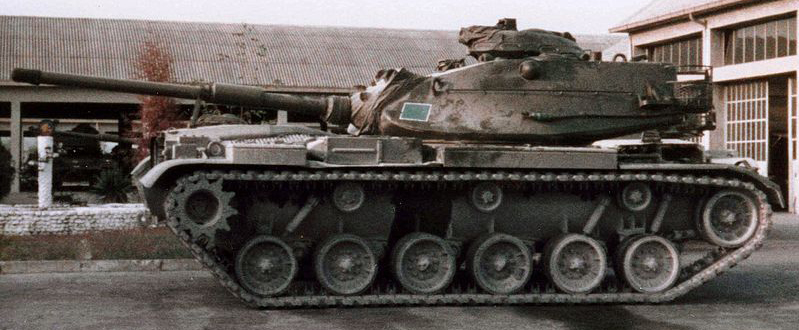
Carro Armato M60A1, the standard Italian M60 Patton. 300 were in service from the 1970s to the 1990s. Now retired.
Leopard 1A5 in service with the Italian Army nowadays. 120 surplus turrets were purchased from the Bundeswehr and served to upgrade 200 A2s hulls purchased in the meantime. The first batch of Leopard 1s (200) was delivered between 1971 and 1972, followed by two batches built by OTO Melara under licence, the first 400 Leopard 1s in 1974-80, and second of 120 build in 1980-1983. In addition OTO Melara assembled 28 Pionierleopard AEV in 1985 (plus 12 produced in Germany) and 64 Bibers AVLBs. All Leopards were gradually retired in 2003 to 2008, leaving only the Ariete in service.
The VCCI, an Italian all-out improvement of the M113 APC. The up-armoured variant with EAAK armor was revealed in 1980 and conversions were made since. The vehicle here is shown without add-on appliqué armour.
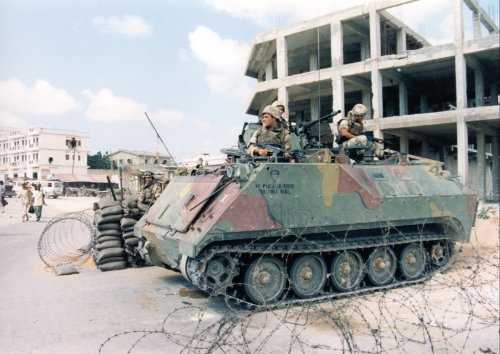
M113 VCCI in the streets of Mogadisciu, 1995.
The Arisgator, a fully amphibious modification of the M113, recalling the US-built LVTP-7 (which was tested by the Italian Army).
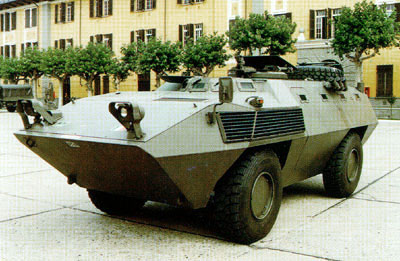
The FIAT 6614 4×4 wheeled amphibious APC (1972): A commercial success together with the 6616 (10 countries), produced to 1443 vehicles combined.
The Palmaria SPG was normally based on the OF-40 chassis, as purchased by Libya, and Nigeria (25). However Argentina purchased about 25 turrets, married with locally stretched and reinforced TAM chassis, to give the VCA Argentine SPG.
The SIDAM-25, a SPAAG adaptation of the versatile M113 (1985).
Illustrations
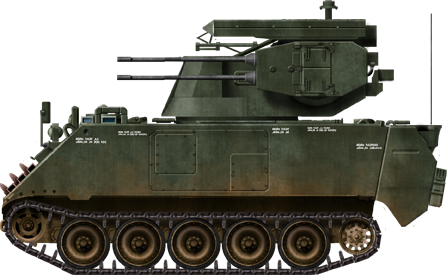
SIDAM 25 with added Mistral surface to air missiles above the guns.
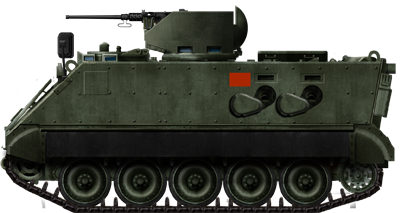
Italian VCC-2 in the 1980s. It was a less advanced conversion than the VCC-1 but has a protected cal.50 operator, 6 mm bolted appliqué armour, two pistol ports with bulletproof glass vision devices. However it could carry 11 infantry as the regular M113 and the amphibious Arisgator. About 1100 to 1760 were produced, now replaced by the VCC-80 Dardo.
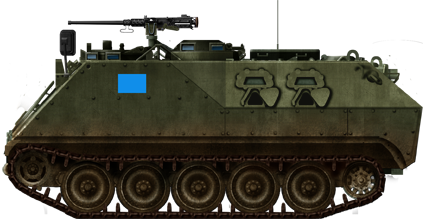
VCC-1 Camillino, first version prior to the Lebanon intervention in 1983. It was basically an Oto Melara improved XM765 (M113A1) with sloped armor and firing ports, but reduced capacity to 7 passengers.
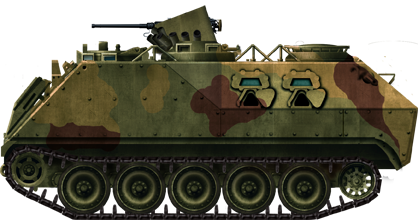
Camouflaged VCC-1 Camillino in the 1980s
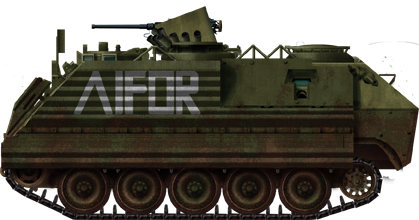
VCC-1 with EAAK Special Spaced Armour (SSA) of the Bersaglieri in Bosnia, 1995. Kits were conceived by RAFAEL (Israel) supplied to Italy by FMS Corp. (now Marvin Land Systems) and were added just in time for the peace keeping forces operating in Somalia.
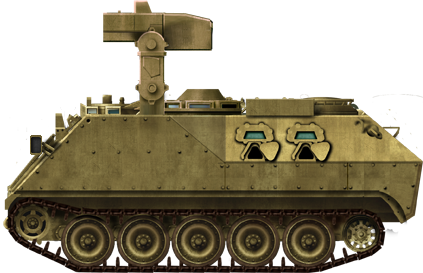
VCC-1 TOW with the licence-built TOW Under-Armour (TUA) turret for the Saudi Arabian Army. 200 to 224 are in service, delivered in 1983-84.

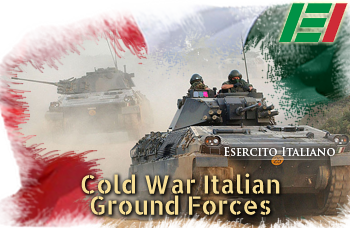



6 replies on “Italian Republic (Cold War)”
Palmaria SPG never enter in service with the E.I.
It has been built only for export: Lybia, 210 unit, Nigeria 25 unit and Argentian 25 turrets ony (as reported also by Wikipedia).
Regards
Indeed, the text contradicted the photo legend, thanks !
Hi people!
A correction. Never see a M48 in Italian Army!!!
Maybe tested
Italy got also a lot of m26 pershings from 1952+
I would love to see a piece on the Italian stuff from World of Tanks, see how much is BS/blueprints/wooden/prototype. They make so much cool stuff in that game and then it turns out its all fake
Hello Wolffe, we may have articles on those in the future.
Thanks
Gareth (TE Manager)